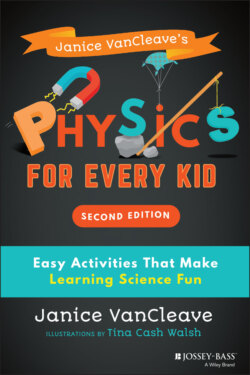Читать книгу Janice VanCleave's Physics for Every Kid - Janice VanCleave - Страница 8
ОглавлениеIntroduction
Throughout the writing of this book, I have daydreamed about the fun I have teaching hands-on physics. I've pictured children and educators enjoying these science activities, while reading instructions that are clear and easy to follow and simple explanations about what happened and why. Science safety was a primary concern when designing the activities in this book. It is my fervent hope that this physics book will ignite a profound curiosity for scientific discovery in readers of all ages. The bottom line is that I want to share my passion for physics and how exciting and relevant science is to our everyday lives.
One doesn't need a degree in science to benefit from learning more about why magnets stick to the fridge door and not to a wooden door. Wonder how a parachute works? Why does a magnifying glass make things look bigger? I imagine children of all ages stopping and questioning the physical world around us. Scientific investigations help develop patterns and higher-level thinking to solve real, everyday problems.
The order of presentation is designed to provide a physics foundation upon which to build new principles of science. The activities in each specific topic spiral in content. Throughout the activities, certain words and phrases are in bold; the meanings of these are given in the Glossary at the end of the book. Working through the activities in order is suggested. However, any activity has educational value on its own merit. With the help of the Glossary, as well as introductions for various topics, you can pick and choose any investigation and be rewarded with a successful experiment. Of course, a good outcome depends upon following the procedure steps in order. Substituting equipment can affect the results for some activities, but science is meant to be fun so trust your judgment about changes.
This book was designed to give the reader a taste of physics:
Energy Learn about stored energy, energy of moving objects and the transfer between them, and the study of different forms of energy including mechanical, electrical, sound, and light. Energy is simply the ability to do work, which means to change or deform or move an object, and to create heat.
Force and Motion Learn about the effect of forces acting on an object, and study about the force of gravity and how it affects falling objects. A study of Sir Isaac Newton's Three Laws of Motion and how they apply to our everyday lives is covered.
Simple Machines Learn about simple machines which are mechanical devices that change the direction and/or magnitude (size) of a force. Levers, inclined planes, wedges, wheels and axles, pulleys, and screws are studied.
Magnets Learn about magnets and their effect, including an invisible field around magnets responsible for the most remarkable property of a magnet, which is a force that pulls on other magnetic materials, such as iron, and attracts or repels other magnets.
The Activities
This book is written to guide you through the steps necessary in successfully completing a science experiment and to present methods of solving problems and making discoveries.
Introduction: Background information provides knowledge about the topic of the investigation and generally describes cause and effect relationships that you can investigate.
See for Yourself: A list of common but necessary materials and step-by-step instructions on how to perform the experiment is provided.
What Happened? A statement of the predicted outcome is provided with a discussion of what should have happened during the activity. A scientific explanation of what was observed is provided using understandable language and technical, scientific vocabulary so that readers of any age can master the scientific principles involved and discuss their findings.
General Instructions
1 Read first. Read each experiment completely before starting.
2 Collect needed supplies. You will experience less frustration and more fun if all the necessary materials for the experiments are ready and set up for easy access.
3 Experiment. Follow each step very carefully, never skip steps, and do not add your own. Safety is of the utmost importance. By reading the experiment before starting, you will be able to note any safety warnings. Then, follow instructions exactly so you can feel confident that your outcome will have the desired results.
4 Observe. If your results are not the same as described in the experiment, carefully reread the instructions, and start over from the beginning. Check to make sure your materials are as described and in good working order. Use the illustrations to see if the activity is set up properly. Consider factors, such as the ambient temperature, humidity, lighting, and so on, that might affect the results.
Measurements
Measuring quantities described in this book are given in imperial units followed by approximate metric equivalents in parentheses. Unless specifically noted, the quantities listed are not critical, and a variation of a very small amount more or less will not alter the results.
